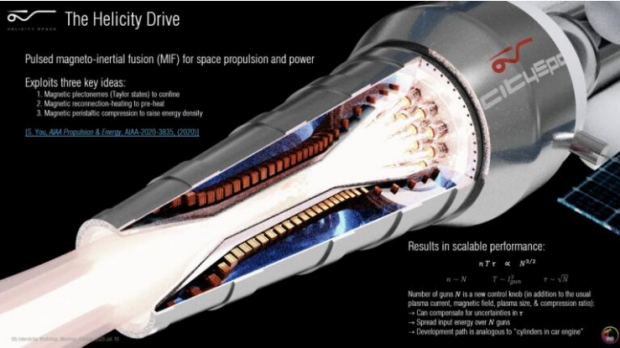Be aware that the Interstellar Research Group has made the videos shot at its Montreal symposium available. I find this a marvelous resource, and hope I never get jaded with the availability of such materials. I can remember hunting desperately for background on talks being given at astronomical conferences I could not attend, and this was just 20 years ago. Now the growing abundance of video makes it possible for those of us who couldn’t be in Montreal to virtually attend the sessions. Nice work by the IRG video team!
There is plentiful material here for the interstellar minded, and I will be drawing on this resource in days ahead. But let’s start with fusion, because it’s a word that all too easily evokes a particular reaction in those of us who have been writing about the field for some time. Fusion has always seemed to be the flower about to bloom, even as decades of research have passed and the target of practical power generation hovers in the future. In terms of propulsion, I’ve long felt that if we had so much trouble igniting fusion on Earth, how much longer would it be before we could translate our knowledge into the tight dimensions of a drive for an interstellar spacecraft?
But if you’ll take a look at Helicity Space’s presentation at the Montreal symposium, you’ll learn about a tightly focused company that approaches fusion from a different direction. Rather than starting with fusion reactors designed to produce power on Earth, Helicity’s entire focus is building a fusion drive for space. NASA’s Alan Stern, of New Horizons fame but also a veteran of decades of space exploration, is senior technical advisor here, and as he puts it, “our goal is not to power up New York City but to push spacecraft.” Stern appeared at Montreal to introduce a panel including Stephane Lintner, the company’s CEO and chief scientist Setthivoine You.

Let’s assume for a moment that at some point in the coming years – we can hope sooner rather than later – we do develop in-space propulsion using fusion. The easiest approach is to contrast working fusion with the methods available to us today. New Horizons was, shortly after launch, the fastest spacecraft ever built; it crossed the orbit of the Moon in a scant 9 hours, but it took a decade to reach Pluto/Charon. We can use gravity assists to sling a payload to the Kuiper Belt, perhaps a craft like JHU/APL’s Interstellar Probe concept, but here we’re dependent on planetary geometry, which isn’t always cooperative, and doesn’t provide the kind of boost that fusion could.
Image: Setthivoine You, co-founder and chief scientist at Helicity Space.
I’m a great advocate of sails, both solar sails and so-called ‘lightsails’ driven by beamed energy, but if reaching a distant target fast is the goal, we’re constrained by the need for a large laser installation and the likelihood, in the near future anyway, of pushing sails that are tiny. New Horizons would take two centuries to reach the Sun’s gravitational lens, a target of JPL’s SGL mission, which will use tight perihelion passes of multiple craft to get up to speed. We continue to talk about decades of travel time, even within the Solar System. As for interstellar, Breakthrough Starshot’s tiny craft, perhaps sent as a swarm to Proxima Centauri, might reach the target in 20 years if all goes well, but data return is a huge problem, and the mission can only be a flyby.
Helicity boldly sketches a future in which we might combine Interstellar Probe and the SGL mission into a single operation using a craft capable of taking a 5 ton payload to the gravitational lens (roughly 600 AU) in a little over a decade. Pluto becomes reachable in some of the Helicity concepts in about a year, with a craft carrying far heavier payloads than New Horizons and abundant power for operations and communications. All this in craft that could be carried into space by existing vehicles like Falcon Heavy or the SLS. The vision reminds us of The Expanse – imagine 4 months to Mars carrying 450 tons of payload as one step along the way.
All of this is a science fictional vision, but the work coming out of Helicity’s labs is solid. It involves so-called peristaltic magnetic compression to compress plasma and raise energy density. The method relies on specific stable behaviors within the plasma, a type of ‘Taylor State’ – these describe plasma within strong magnetic fields – discovered by You. These confine the plasma, while magnetic reconnection heating preheats it in the first place. Setthivoine You describes all this in the video, noting that what Helicity is developing is a method that we can consider magneto-inertial confinement, one producing a plasma jet stabilized through shear flows within the plasma itself. The firm’s computer simulations, in collaboration with Los Alamos National Laboratories, show four jets merging in a double-helix fashion inside the magnetic nozzle. You’s slides, available in the video, are instructive and dramatic.

What emerges from these results is scalable performance, allowing a path forward that the firm hopes to test as early as 2026 in a demonstration flight in orbit, with the possibility of a functional spacecraft at TRL 9 within roughly a decade. The scalable design points to the possibility of compact, reusable spacecraft with the unique feature of continuous thrusting. Think of the Helicity system, Stern has suggested, as a kind of afterburner put onto an electric propulsion system, and one that can scale into a working fusion drive. The concept scales by adding more fusion jets, allowing higher and higher efficiency, until the engine eventually becomes self-sustaining – the energy required to sustain the thrust is less than what the fusion begins to generate.
Does Helicity’s technology have the inside track, or will a contender like the UK’s Pulsar Fusion get to in-space fusion first? The latter is working on a study with Princeton Satellite Systems to examine plasma characteristics in a fusion rocket engine. Helicity’s founders are appropriately cautious about their work and stress how much needs to be learned, but they are continuing to develop the concept in their prototypes. With its laboratory in Pasadena, the company is privately funded and maintains active collaborations with Caltech and Los Alamos as well as UMBC and Swarthmore. Grants from the Department of Energy and other sources have likewise contributed. Have a look at the Montreal video to get a sense of where this exciting research stands, and also a glimpse of the kind of future that in-space fusion propulsion could produce.



Always good to see another approach to building a fusion rocket to drive those torch ships across the solar system. I note that Stern was very careful to manage expectations on performance and limited the useful distances to 100s of AUs, and not light years.
This drive is still a rocket, and the rocket equation still remains relevant. To get the high thrust they must inject a propellant. So assuming that the drive uses no additional propellant and it is self-sustaining, it seems that the ISP is of the order of 1E4 – 1E5.
Using the higher value, and assuming we want to reach 0.1c, this is of the order of deltaV of 10x the Isp x g so the needed M0/M1 ratio is ~20,000. The M1 would have to have a similar ratio to decelerate.
So assuming these fusion drives work as advertised, they would be good for traveling in our system and beyond out to perhaps 1000AU, but not for “fast” interstellar ships.
What interested me more, was the intermediate stage, where the drive was more like a solar electric engine but with the fusion able to reduce the power requirements and with added propellant to provide a higher thrust, particularly at the start and end of a flight. Depending on the efficiencies of energy conversion and needed collector mass, this might be another opportunity to deliver power by beam. To partially mitigate the problem of beam dispersion, the ship could deploy a large, spinning, thin-film Fresnel lens to collect the laser light and concentrate it on a smaller collector, thus allowing the ship to collect power much further away from the beam, which would facilitate longer acceleration times.
Even if the fusion reaction was self-sustaining, beamed power might be a useful “kickstarter” to fire up the engine from a cold start.
A minor issue that the team seemed to somewhat hand-wave away was the neutron flux. Distance and shielding would reduce the effects on the payload… err, crew, but it would degrade the engine itself, either requiring the rocket engine to be disposable, or at least reducing reusability. [Back in the 1980s, Bussard had suggested disposable fusion reactor cores to avoid the problem of neutrons degrading the structures. This might be a possible approach to keep the fusion rocket engine lightweight and cheap enough to be replaced like flashbulbs.]
Yes, the neutron issue bothered me as well. I’d like to hear a fuller explanation of it from someone on the team.
Earthxit
Hi Paul & Alex
Nice to see a mention of Bussard’s Riggatron, which has an interesting little excursus into fusion propulsion concepts. There was a fusion-propelled Space Tug concept mentioned incidentally in a Closed-Loop Life Support paper in the early 1980’s, which has inspired many a quest to find more details. From the illustration it looks suspiciously like a Riggatron and the paper mentions a private phone call with Bussard himself. Next mention of a low-thrust fusion drive by Bussard was about 5 years later, where he explicitly discusses the use of a Riggatron like fusion propulsion system for continuous transfer propulsion to Mars. Might be worth a revisit.
A timely thought, Adam. Thanks for the suggestion!
Looking at Elmar Moelzer’s table, I think the difference betwen fusion power and thrust power is about what Robert Freeland calculated for the Z-pinch, i.e lots of neutrons and x-rays. For a 7 GW fusion they get 2,5 GW thrust power for DD and about twice that for D-He3, but still plenty of losses.
https://forum.nasaspaceflight.com/index.php?topic=5367.3940
The provided link goes to the page with the cited table. Here is a direct link to the table provided by Elmer Moetzer:
https://forum.nasaspaceflight.com/index.php?topic=5367.msg2519878#msg2519878
Here is another post from that site which has a link to the cited paper that you can download for free as well as some comments:
https://forum.nasaspaceflight.com/index.php?topic=5367.msg2518550#msg2518550
The thread on this site would be a good place to further discuss technical details of this proposal.
I would like too see more thought into firstlight fusions concept where a linear impactor is used too spherical implode a fusion material. They are working towards implosion velocities of around 800km/s and tens of terrapascal pressures. If applied to fissile material it would greatly reduce the amount of fissile fuel required from kg’s to grams or less. A combination of fusion and fissile material may work better though.
https://youtu.be/aTMPigL7FB8
Interesting post, thanks for sharing.
At least two aspects appear to differentiate this fusion proposal from other approaches: exploiting helicity for containment and N^(3/2) scaling for N merged plectonemes using magnetic reconnection to reach high temperatures. The demonstration mentioned for the end of this year for N=4 will be a key milestone.
Magnetic compression and magnetic nozzles are not a new concept. The combination of supercomputer simulations and laboratory experiments should reduce risk in achieving orbital demonstrations within a time frames of years.
I signed up at https://www.helicityspace.com to get updates on this.